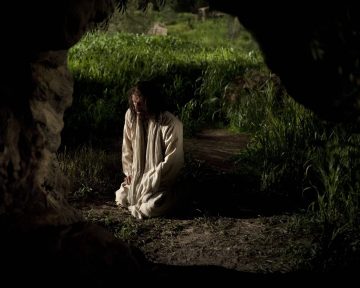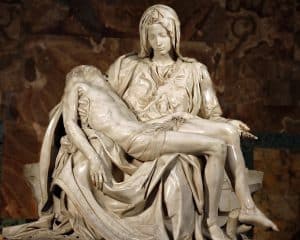Guest Post by Vada
(Note = Author’s thoughts and words are in italics, while direct quotes from the Gospel Principles lesson manual or scriptures are not italicized.)
The Atonement
Invite the class to silently read Luke 22:39–46 or watch this video.
As they read or watch, invite them to consider these questions:
- What happened in Gethsemane?
- Why is it important to me?
The Savior Suffers in Gethsemane
The Atonement Is Necessary for Our Salvation
The first section of the Gospel Principles manual, Chapter 12: The Atonement, gives a nice introduction to the atonement. I would start by reading it verbatim.
Jesus Christ “came into the world … to be crucified for the world, and to bear the sins of the world, and to sanctify the world, and to cleanse it from all unrighteousness; that through him all might be saved” (D&C 76:41–42). The great sacrifice He made to pay for our sins and overcome death is called the Atonement. It is the most important event that has ever occurred in the history of mankind: “For it is expedient that an atonement should be made; for according to the great plan of the Eternal God there must be an atonement made, or else all mankind must unavoidably perish; … yea, all are fallen and are lost, and must perish except it be through the atonement” (Alma 34:9).
The Fall of Adam brought two kinds of death into the world: physical death and spiritual death. Physical death is separation of the body and spirit. Spiritual death is separation from God. If these two kinds of death had not been overcome by Jesus Christ’s Atonement, two consequences would have resulted: our bodies and our spirits would have been separated forever, and we could not have lived again with our Heavenly Father (see 2 Nephi 9:7–9).
But our wise Heavenly Father prepared a wonderful, merciful plan to save us from physical and spiritual death. He planned for a Savior to come to earth to [redeem] us from our sins and from death. Because of our sins and the weakness of our mortal bodies, we could not ransom ourselves (see Alma 34:10–12). The one who would be our Savior would need to be sinless and to have power over death.
Jesus Christ Was the Only One Who Could Atone for Our Sins
This section starts with a nice discussion question, which I would ask the class and let them answer. The two paragraphs from the lesson manual and the one scriptural quote following can be used, as needed, to say anything the class might have missed or to reinforce what they said.
• Why was Jesus Christ the only one who could atone for our sins?
There are several reasons why Jesus Christ was the only person who could be our Savior. One reason is that Heavenly Father chose Him to be the Savior. He was the Only Begotten Son of God and thus had power over death. Jesus explained: “I lay down my life, that I might take it again. No man taketh it from me, but I lay it down of myself. I have power to lay it down, and I have power to take it again” (John 10:17–18).
“For it is expedient that there should be a great and last sacrifice; yea, not a sacrifice of man, neither of beast, neither of any manner of fowl; for it shall not be a human sacrifice; but it must be an infinite and eternal sacrifice. … and that great and last sacrifice will be the Son of God, yea, infinite and eternal.” (Alma 34:10,14)
Jesus also qualified to be our Savior because He is the only person who has ever lived on the earth who did not sin. This made Him a worthy sacrifice to pay for the sins of others.
Christ Suffered and Died to Atone for Our Sins
I think this is the best place in the lesson for going “off-book”, as it were, and really talking about what the atonement means and can mean to each of us in our lives.
The Savior atoned for our sins by suffering in Gethsemane and by giving His life on the cross. It is impossible for us to fully understand how He suffered for all of our sins.
He not only suffered to atone for our sins, but so that he could better understand us and what we go through in this life. In Alma, Chapter 7, verses 11 through 12, it says:
And he shall go forth, suffering pains and afflictions and temptations of every kind; and this that the word might be fulfilled which saith he will take upon him the pains and the sicknesses of his people.
And he will take upon him death, that he may loose the bands of death which bind his people; and he will take upon him their infirmities, that his bowels may be filled with mercy, according to the flesh, that he may know according to the flesh how to succor his people according to their infirmities.
Though I don’t know exactly how it all works, I take great comfort in the fact that when I am suffering at least one person understands how I feel. It helps me to feel less alone in what are often the loneliest times of my life.
How has Christ and His atonement helped you in your life?
Obviously, I would give class members a chance to share their own experiences here, before moving on to the end of the section.
How Jesus loves us, to suffer such spiritual and physical agony for our sake! How great the love of Heavenly Father that He would send His Only Begotten Son to suffer and die for the rest of His children. “For God so loved the world, that he gave his only begotten Son, that whosoever believeth in him should not perish, but have everlasting life” (John 3:16).
The Atonement and Resurrection Bring Resurrection to All
As it said at the beginning of the lesson, the Atonement saves us from physical death, or the separation of our bodies and spirits.
On the third day after His Crucifixion, Christ took up His body again and became the first person to be resurrected. When His friends went to seek Him, the angels who guarded His tomb told them, “He is not here: for he is risen, as he said” (Matthew 28:6). His spirit had reentered His body, never to be separated again.
Christ thus overcame physical death. Because of His Atonement, everyone born on this earth will be resurrected (see 1 Corinthians 15:21–22). Just as Jesus was resurrected, our spirits will be reunited with our bodies, “that they can die no more … , never to be divided” (Alma 11:45). This condition is called immortality. All people who have ever lived will be resurrected, “both old and young, both bond and free, both male and female, both the wicked and the righteous” (Alma 11:44).
• How has your knowledge of the Resurrection helped you?
The Atonement Makes It Possible for Those Who Have Faith in Christ to Be Saved from Their Sins
The Savior’s Atonement makes it possible for us to overcome spiritual death.
Although everyone will be resurrected and saved from physical death, we will have to choose to accept his Atonement to be saved from spiritual death and redeemed from our sins.
We accept Christ’s Atonement by placing our faith in Him. Through this faith, we repent of our sins, are baptized, receive the Holy Ghost, and obey His commandments. We become faithful disciples of Jesus Christ. We are forgiven and cleansed from sin and prepared to return and live forever with our Heavenly Father.
The Savior tells us, “For behold, I, God, have suffered these things for all, that they might not suffer … even as I” (D&C 19:16–17). Christ did His part to atone for our sins. To make His Atonement fully effective in our lives, we must strive to obey Him and repent of our sins.
Here the lesson manual has a parable that I don’t particularly like, because it depicts a very harsh and unloving God, which is not how I choose to picture God. Instead of reading this story, I would say something along these lines:
When we sin, we separate ourselves from God. As it says in Mosiah 2:38:
Therefore if that man repenteth not, and remaineth and dieth an enemy to God, the demands of divine justice do awaken his immortal soul to a lively sense of his own guilt, which doth cause him to shrink from the presence of the Lord, and doth fill his breast with guilt, and pain, and anguish, which is like an unquenchable fire, whose flame ascendeth up forever and ever.
Christ has atoned for us so that we do not need to endure this fate, if only we will accept his mercy and grace. It says in Alma 34, verses 15 and 16:
And thus he shall bring salvation to all those who shall believe on his name; this being the intent of this last sacrifice, to bring about the bowels of mercy, which overpowereth justice, and bringeth about means unto men that they may have faith unto repentance.
And thus mercy can satisfy the demands of justice, and encircles them in the arms of safety, while he that exercises no faith unto repentance is exposed to the whole law of the demands of justice; therefore only unto him that has faith unto repentance is brought about the great and eternal plan of redemption.
I would then go back to the lesson manual.
Without Jesus Christ, who is our Savior and Mediator, we would all pay for our sins by suffering spiritual death. But because of Him, if we will keep His terms, which are to repent and keep His commandments, we may return to live with our Heavenly Father.
It is wonderful that Christ has provided us a way to be healed from our sins. He said:
“Behold, I have come unto the world … to save the world from sin.
“Therefore, whoso repenteth and cometh unto me as a little child, him will I receive, for of such is the kingdom of God. Behold, for such I have laid down my life, and have taken it up again; therefore repent, and come unto me ye ends of the earth, and be saved” (3 Nephi 9:21–22).
• Ponder how you can show gratitude for the gift of the Atonement.
Note: This lesson is adapted from a lesson originally written for Gospel Principles manual, Chapter 12: The Atonement and for the Relief Society audience in 2010-2011, when the Gospel Principles manual was temporarily used as curriculum for Relief Society, Elders Quorum and High Priest classes.






15 Responses
thankyou for this lesson plan! The suggestions will be quite helpful to me.
You’re site is always so helpful to me in preparing my lessons! So THANK YOU!!!!
This lesson is a little intimidating because the Atonement is such a HUGE deal! :0) I am planning on showing the Atonement from The Testaments movie. I feel this can portray the Atonement much better than I could ever teach it! Of course it’s only about 5 mins…. :0) But i know that the Spirit will be felt!
I also thought I would ask 4 ladies to read the parable, in story form. It’s a little different and I think the women will appreciate hearing it in story form versus reading it aloud.
Again, I really appreciate your insight in preparing these lessons!
I think I am going to start off with an object lesson called The cleansing power of the Atonement here is a video clip of it.
http://www.sugardoodle.net/joomla/index.php?option=com_content&view=article&id=6212
Also I liked the handout of that on this website
http://ldshandouts.blogspot.com/2009/12/atonement-quote.html
I have dyslexia so reading is hard. So I learn best and teach better when I have at least one of these. An object lesson, video, handout, music, and always open discussions.
You have always helped me gather ideas and have helped me in so many ways. Thank you
I love your site and find it extremely helpfuly each month that I teach. I have been teaching 18 months and this is the hardet lesson I have had to pull together. I don’t know why??
To Becoming LDS: thank you so much for clarifying the parable! I was also a little hesitant to present it because I thought the Creditor represented God. But like Courtney, I’m going to have a few sisters come “act out” the parable, kindof in skit form. I think it will be helpful.
To Jaylynn – I wish I could show that clip too! But I’d have to have a laptop and internet access to be able to show it… or is there another way??
Thanks everyone for your comments! It’s all so helpful! Best wishes for a wonderful, spirit-filled lesson!
To Chelsea… probably late at this point but you may download the video clip from lds.org and save it to the hard drive or even on a CD / DVD and then play it from either of those sources. We don’t have internet access in our building either.
Thank you for these helps! Another source I found very helpful: http://www.lds.org/ldsorg/v/index.jsp?locale=0&sourceId=968539b439c98010VgnVCM1000004d82620a____&vgnextfmt=tab4&vgnextoid=76bd3f7719605010VgnVCM1000004e94610aRCRD
I especially learned from and was inspired by Elder Faust’s talk “The Atonement: Our Greatest Hope” and Elder Ballard’s talk “The Atonement and the Value of One Soul.” I will be thinking of all of you and our other sisters around the world teaching this lesson of hope Sunday.
lesson 14 Priestood organization do you have any hand out’s for this lesson? can you help me at all.
Thanks Dorothy